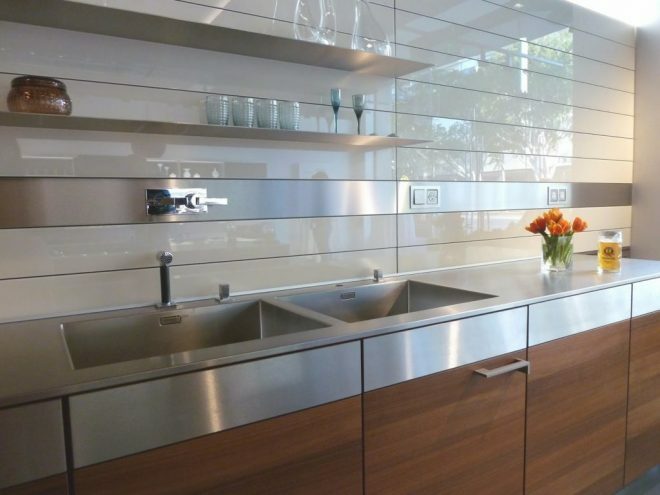The use of decorative stone in the kitchen brings sophistication and nobility to the interior. The stone attracts attention, skillfully sets accents. When combined with wood, it is possible to arrange a country-style kitchen, Provence. Black and white porcelain stoneware, acrylic stone in combination with plastic and chrome elements in the interior will suit the style of modern, high-tech, loft, minimalism. And of course, the most luxurious interiors in the Romanesque, English, antique styles are obtained thanks to marble, malachite, mother-of-pearl.
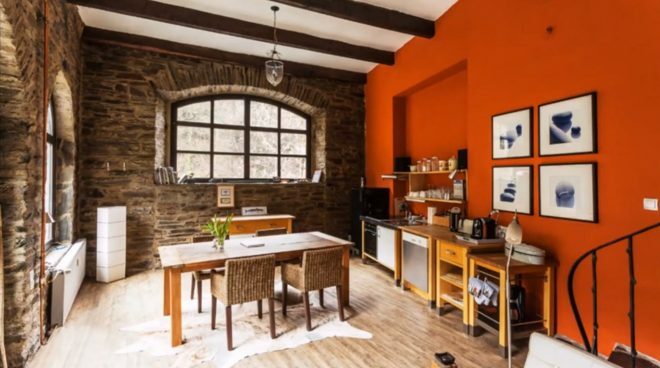
Image taken from https://www.youtube.com/watch? v = QHBDOjyFFNc
The advantages of this finish
Decorating a kitchen under a stone is not only beautiful, but also beneficial from a technical point of view. The material has such qualities as:
- durability - does not deteriorate for decades;
- environmental friendliness - does not emit harmful substances;
- withstands temperature extremes and high humidity;
- antistatic - dust does not accumulate;
- resistance to mechanical damage;
- the surface is easy to clean - dry or damp cleaning with a rag is enough;
- installation can even be done by a non-professional;
- heterogeneous texture hides surface imperfections;
- does not absorb moisture and dirt.
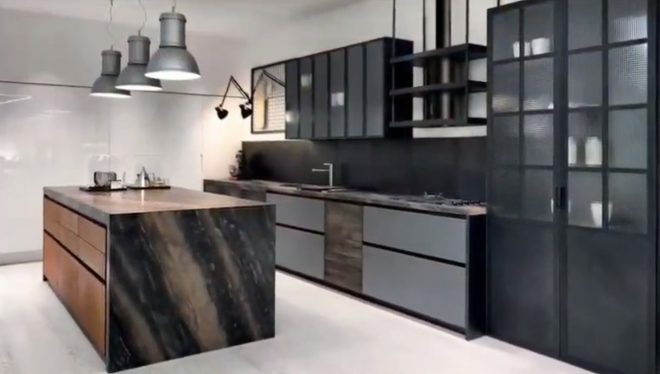
Image taken from https://www.youtube.com/watch? v = yIXtH5ztFb4
Artificial or natural stone?
Stone kitchens are designed using natural or artificial materials. From natural rocks, they use slate (has a layered structure), river stone, sandstone (warm pleasant shades), granite (one of the hardest stones), marble (expensive and noble), travertine, limestone, onyx, cobblestone (for decorating bar racks).
Attention! Earned on our website kitchen designer. You can familiarize yourself with it and design your dream kitchen for free! May also come in handy wardrobes designer.
Artificial stone is made from natural raw materials - stone chips. It imitates the structure of natural marble, granite, bassoon, sandstone or brick. Such material combines the beauty of the appearance of natural stone with the light weight of the product, ease of installation. So, when working with artificial stone, it is not necessary to additionally reinforce the surface. You can find a product of any color: blue, orange, red - a wide field for designer imagination.
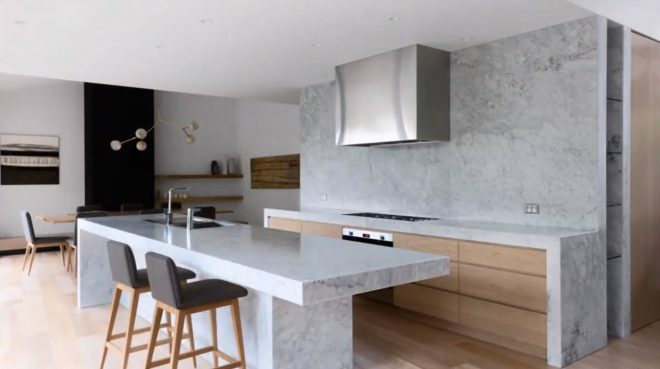
Image taken from https://www.youtube.com/watch? v = QHBDOjyFFNc
Artificial decorative stone
Artificial stone is obtained by pressing various natural components at high temperatures and in a vacuum. Therefore, it is an even stronger and more durable material. No micropores remain on the surface in which microbes could develop. In a kitchen made of artificial stone, even with the constant presence of food residues, in conditions of high humidity and temperature, fungus and other harmful microorganisms do not multiply.

Image taken from https://www.youtube.com/watch? v = 0fJInr6rtlE
A natural stone
Decorating the kitchen with stone is done with natural materials after they have been sorted and given the desired shape. The natural breed is valued for its unique pattern and texture, created by nature itself. At the same time, it is technically more difficult to work with it:
- large weight of products;
- chips and cracks are possible, after which the products cannot be restored;
- the stone surface is almost always cold;
- the joints are visible.
Marble has a porous structure. Because of this, stains can remain on the surface, and it is also sensitive to acids.

Image taken from https://www.youtube.com/watch? v = QHBDOjyFFNc
Types of stone for decoration
There are mainly 3 types of artificial stone used:
- Agglomerates, or acrylic stone based on granite chips, marble, quartz sand, limestone. It is lighter than its natural counterparts and is characterized by even greater strength. Has a huge selection of colors and patterns, resistant to temperatures. It is not recommended to place the stone in the kitchen in direct sunlight, as the colors may fade over time. Care must be taken when choosing a cleaning agent. Does not burn and does not emit harmful substances under the influence of high temperature. Suitable for wall decoration, backsplash, work surfaces.
- Porcelain stoneware consists of clay, spar, minerals. It is used in the work area, for window sills and countertops.
- Concrete Brick and Stone: Imitate brick, shell rock, savage. An inexpensive option, suitable for wall decoration, presented in different colors and textures. You should not choose for an apron due to insufficient moisture resistance.
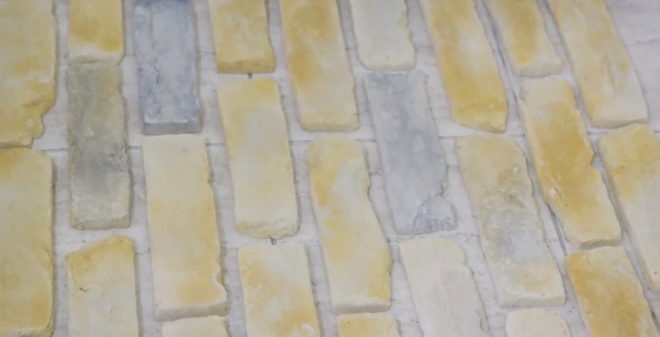
Image taken from https://www.youtube.com/watch? v = 0fJInr6rtlE
Piece
These are clearly defined rectangular blocks that can be used as wall panels or cladding. In the room, rectangular slabs are laid separately. Decorating the kitchen with decorative stone can be done by American, English, Flemish dressing. In addition to standard rectangular materials, corner models can be found on sale, which greatly facilitates the facing of hard-to-reach places.
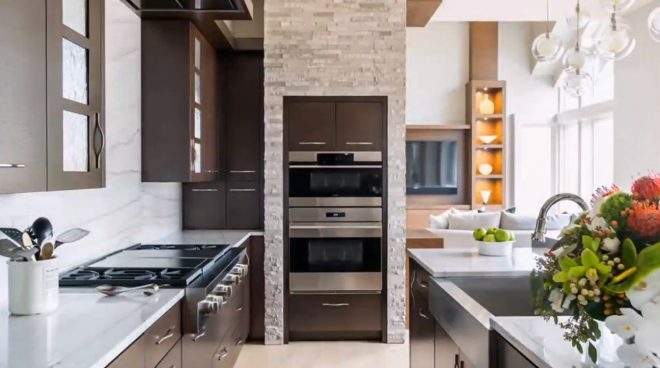
Image taken from https://www.youtube.com/watch? v = QHBDOjyFFNc
Panels
These are rectangular or square blocks with imitation of stone or tiles. Their main advantage is ease of installation and ease. The panels do not weigh down the overall structure. There are rack, tiled, PVC sheet options. The panels simplify and speed up wall cladding and are virtually invisible to the seams. Decorating with decorative stone in the form of a wall panel is often done in the area of the apron. Considering that this is an inflexible product with a thickness of 12 mm, it is important that the floor is perfectly horizontal and the wall surface is smooth.
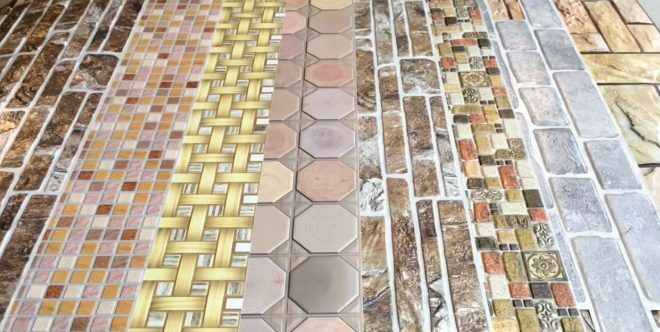
Image taken from https://www.youtube.com/watch? v = 97y9Mp7IH5Y
Gypsum stone
The name speaks for itself - it is an artificial plaster material that can be shaped into any shape (brick, rubble or chipped stone, as well as tiles). Artificial stone in the gypsum kitchen is lighter, so it can be mounted on plasterboard walls. Among the disadvantages - it is porous, it can saturate water at high humidity. Coated with acrylic varnish for protection. Quite fragile, but its price is much lower.
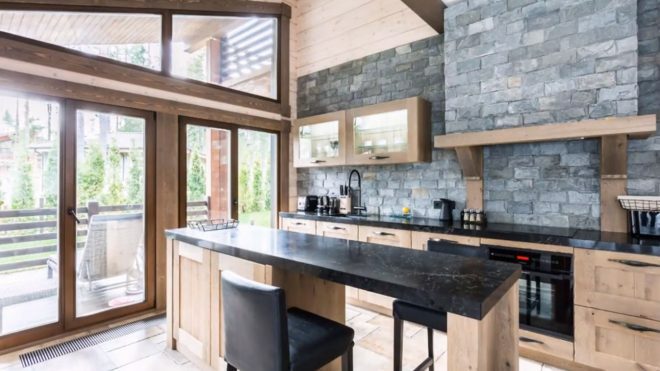
Image taken from https://www.youtube.com/watch? v = QHBDOjyFFNc
Flexible stone
It is a thin section of compressed stone chips on a strong flexible base. Stone wallpaper can be in rolls or tiles. The main advantages are:
- light weight - can be used on thin surfaces;
- plasticity - it is easy to decorate curvilinear structures of arches, corners, columns, fireplaces with complex shapes;
- withstand high temperatures well;
- no condensation forms at high humidity.
Stone kitchens are often decorated in marble or sandstone.

Image taken from https://www.youtube.com/watch? v = k6T4GY-FWF4
Plaster
Artificial stone kitchens can be created using plaster solutions. This is an original and unrepeatable coating that provides a lot of room for imagination. With its help, you can make patterns, relief, imitate natural surfaces. Decorative plaster can be marbled, malachite, sandstone, granite. Technically, it can be done in the form:
- flat - Venetian plaster;
- textured (with a rough surface) - Roman stone;
- flat-relief (the seams are slightly deepened) - imitation of a brick wall;
- convex masonry (relief height more than 1 cm).
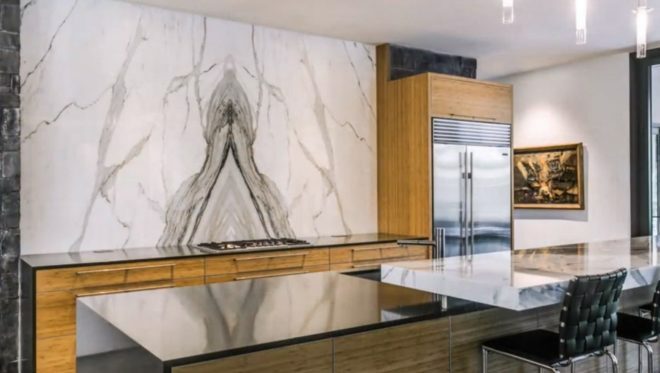
Image taken from https://www.youtube.com/watch? v = QHBDOjyFFNc
The plaster should be applied on a prepared and carefully leveled surface. To do this, use lime, gypsum or cement-sand mortar. This is followed by a few layers of primer and then the plaster itself. Depending on the type of coating, it is applied with a brush, spatula or trowel.
Scope of artificial stone
Decorative stone in the interior of the kitchen can occupy all walls or just one, located on a door or window opening. You can make splashes from individual stone fragments into other finishes. Sometimes they decorate a stone panel on the wall, lay out original ornaments. The practice of finishing the kitchen set with decorative stone, bar counter, columns, door and window openings, arches.
Apron in the kitchen
An artificial stone apron protects the wall from dirt near the stove, sink and work surface. In this zone, the greatest requirements for the quality of the material: resistance to high temperature, humidity, pollution, cleaning agents, fire safety are required.
Acrylic stone, quartz, porcelain stoneware meet such high requirements. Acrylic is resistant to acids, alkalis, aggressive detergents. Amenable to polishing, repair, warm to the touch. You can make a seamless surface.
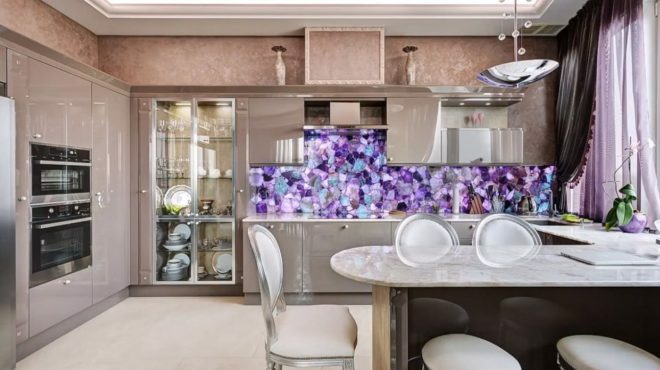
Image taken from https://www.youtube.com/watch? v = QHBDOjyFFNc
The use of gypsum and sandstone is not recommended due to moisture sensitivity. If necessary, they can be coated with a protective varnish. Porcelain stoneware and marble are sensitive to abrasive detergents.
Given the need for frequent cleaning, it is not recommended to emboss the coating. Often a material with a smooth surface is combined with a countertop. It should not be cleaned with iron brushes using abrasive and acidic substances. You need to put a stand under the hot, cut on a cutting board.
Walls
For walls, an imitation of brick or masonry made of colored concrete is often chosen. Walls away from the work surface are less demanding on the material. The choice is due to financial capabilities and personal preferences. It is not recommended to decorate all walls with stone, this will make the room cumbersome. You can focus on the wall near the dining table, adding coziness to the corner where the whole family gathers. Artificial stone on the kitchen wall goes well with photo wallpaper, decorative plaster, neutral paint, plain wallpaper.
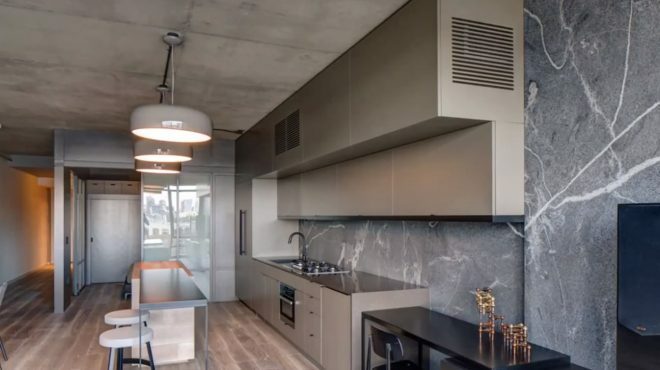
Image taken from https://www.youtube.com/watch? v = QHBDOjyFFNc
The dimensions of the kitchen also dictate their own requirements: in a small room, they use light and less textured materials with a horizontal relief. In large rooms, you can experiment more boldly: decorate in the Provence style with high ceilings made of wood or use dark materials with local lighting.
Door and window openings
If you lay out the entrance to the kitchen or window openings with stone, this will significantly decorate the room, made in monochromatic colors. The decorative stone on the kitchen arch strengthens it and visually expands the space. The kitchen becomes like a medieval castle.

Image taken from https://www.youtube.com/watch? v = QHBDOjyFFNc
Ventilation box
The hood is always in a conspicuous place. Artificial stone for the kitchen allows you not only to hide it, but also to turn it into a dignity and decoration of the room. They often create an imitation of a fireplace around the hood. For the base, a galvanized profile and drywall are used, which are covered with decorative stone on top.
So, the stone will give any kitchen a unique look. However, a sense of proportion is needed so as not to "overload" the situation. You should choose furniture and other finishing materials that are in harmony with the entire interior of the kitchen.
average rating 0 / 5. Number of ratings: 0
No ratings yet. Be the first to rate.


